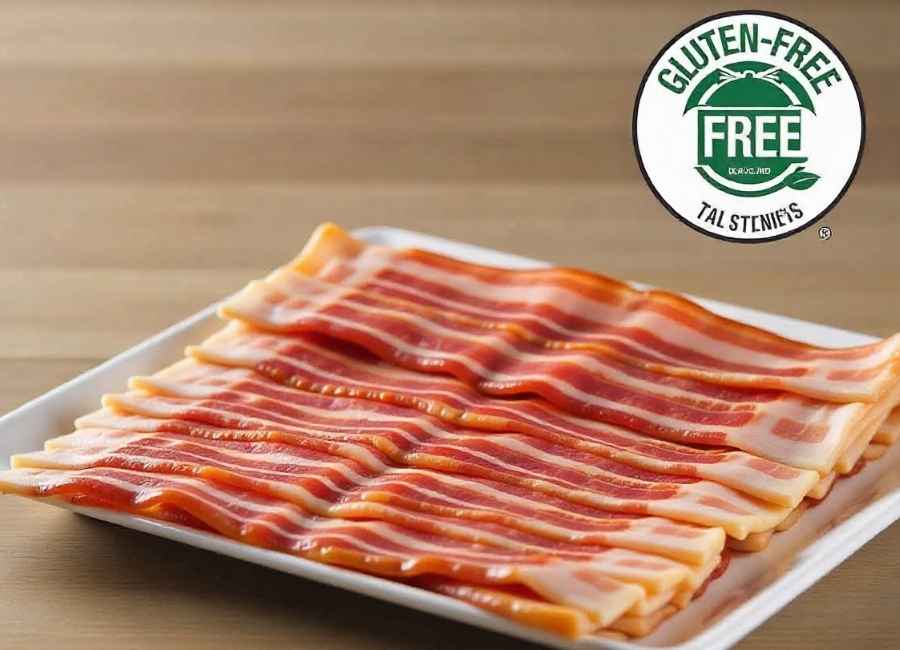If you’re following a gluten-free diet, you’ve probably found yourself scrutinizing food labels more than ever. While some foods are obviously safe (hello, fresh fruits and vegetables), others fall into a gray area that can leave you second-guessing your grocery cart choices.
Bacon is one of those foods. At first glance, it seems straightforward—it’s just cured pork, right? But the reality is a bit more complicated. Some bacon is naturally gluten-free, while other varieties contain hidden sources of gluten that could trigger symptoms if you have celiac disease or gluten sensitivity.
This guide will help you understand when bacon is safe to eat on a gluten-free diet, which brands to trust, and what to watch out for when shopping or dining out.
The Short Answer: Most Bacon Is Gluten-Free (But Not All)

Plain bacon made from pork belly, salt, and natural seasonings is typically gluten-free. The issue arises when manufacturers add flavorings, preservatives, or sweeteners that contain gluten.
Common culprits include:
- Malt flavoring (derived from barley)
- Soy sauce (often contains wheat)
- Modified food starch (can be sourced from wheat)
- Wheat-based fillers in lower-quality bacon
Most major bacon brands use gluten-free ingredients; however, cross-contamination during processing remains a risk if the facility also handles gluten-containing products.
Why Some Bacon Contains Gluten

Bacon undergoes a curing process that involves the addition of salt, sugar, and various flavorings. This is where gluten can sneak in.
Flavorings and Additives
Flavored bacon varieties—like maple, honey, or applewood-smoked—are more likely to contain gluten. Malt syrup, a common flavoring agent, is made from barley and contains gluten. Similarly, some manufacturers use soy sauce (which typically includes wheat) to add depth to the flavor profile.
Cross-Contamination
Even if bacon doesn’t list gluten-containing ingredients, it might be processed in a facility that handles wheat products. For people with celiac disease, even trace amounts of gluten can cause an immune response.
Pre-Cooked and Restaurant Bacon
Pre-cooked bacon and bacon served at restaurants can be especially risky. Pre-cooked varieties often contain stabilizers or flavor enhancers that may include gluten. Restaurant bacon might be prepared on shared grills or cooked alongside gluten-containing foods, leading to cross-contamination.
How to Find Gluten-Free Bacon

Shopping for bacon when you need to avoid gluten doesn’t have to be stressful. Here’s what to look for.
Read the Label Carefully
Start by checking the ingredient list. Look for simple ingredients, such as pork, water, salt, sugar, and sodium nitrite. Avoid bacon with vague terms like “natural flavors” unless the package states explicitly that it’s gluten-free.
Look for a Gluten-Free Certification
Some brands carry a certified gluten-free label from organizations like the Gluten-Free Certification Organization (GFCO). This certification means the product contains less than 10 parts per million (ppm) of gluten—well below the FDA’s threshold of 20 ppm.
Stick to Trusted Brands
Several popular bacon brands are considered safe for gluten-free diets, including:
- Applegate: Offers organic and natural bacon varieties that are gluten-free
- Hormel Black Label: Most varieties are gluten-free, but always check the label
- Wellshire Farms: Known for gluten-free, nitrate-free bacon options
- Trader Joe’s: Many of their bacon products are gluten-free
When in doubt, contact the manufacturer directly to confirm their gluten-free status and inquire about their cross-contamination protocols.
Buy Fresh, Uncured Bacon
Uncured bacon (bacon without added nitrites or nitrates) tends to have fewer additives and a simpler ingredient list. While “uncured” doesn’t automatically mean gluten-free, it often reduces the risk of hidden gluten ingredients.
What About Bacon Alternatives?
If you’re avoiding pork for dietary or religious reasons, you might be wondering about bacon alternatives like turkey bacon or plant-based bacon.
Turkey Bacon
Turkey bacon is generally gluten-free, but the same rules apply: check the label for hidden gluten in seasonings or fillers. Brands like Butterball and Jennie-O offer gluten-free turkey bacon options.
Plant-Based Bacon
Plant-based bacon made from ingredients like coconut, tempeh, or soy can be gluten-free, but many varieties contain wheat or barley-based flavorings. Always verify the ingredients before purchasing.
Dining Out: How to Order Bacon Safely

Eating bacon at restaurants requires extra caution. Here are some tips to reduce your risk of gluten exposure.
Ask Questions
Don’t hesitate to ask your server how the bacon is prepared. Is it cooked on a shared grill? Does it contain any marinades or seasonings? Many restaurants are familiar with gluten-free requests and can provide this information.
Request Plain Bacon
If possible, ask for plain, unflavored bacon. Skip the candied or glazed varieties, which are more likely to contain gluten.
Watch for Cross-Contamination
Even if the bacon itself is gluten-free, cross-contamination can occur if it’s cooked alongside pancakes, French toast, or other gluten-containing breakfast items. Request that your bacon be cooked separately if you have celiac disease.
Symptoms of Gluten Exposure
If you accidentally consume gluten, symptoms can vary depending on whether you have celiac disease, non-celiac gluten sensitivity, or a wheat allergy.
Common symptoms include:
- Bloating and abdominal pain
- Diarrhea or constipation
- Fatigue
- Headaches
- Skin rashes (like dermatitis herpetiformis in celiac disease)
If you suspect you’ve been exposed to gluten, stay hydrated and consult your doctor if symptoms persist or worsen.
Can You Make Your Own Gluten-Free Bacon?
If you want complete control over what goes into your bacon, consider making it at home. Curing bacon is simpler than you might think.
Basic Homemade Bacon Recipe
Ingredients:
- 5 lbs pork belly
- ¼ cup kosher salt
- ¼ cup brown sugar (ensure it’s gluten-free)
- 2 tsp pink curing salt (optional, for color and preservation)
- Black pepper and spices to taste
Instructions:
- Mix the salt, sugar, and spices in a bowl.
- Rub the mixture all over the pork belly.
- Place the pork belly in a large resealable bag and refrigerate for 7 days, flipping daily.
- Rinse off the cure, pat dry, and smoke or bake at 200°F until the internal temperature reaches 150°F.
- Slice and cook as desired.
Homemade bacon allows you to avoid preservatives, control sodium levels, and ensure it’s completely gluten-free.
The Bottom Line: Bacon Can Be Gluten-Free
Most plain bacon is naturally gluten-free; however, flavored varieties and specific brands may contain hidden gluten. Always read labels carefully, look for certified gluten-free products, and ask questions when dining out to ensure a safe and gluten-free experience.
With a bit of diligence, you can enjoy crispy, savory bacon without worrying about gluten. Whether you’re cooking breakfast at home or ordering brunch at your favorite restaurant, knowing what to look for will help you make safe, delicious choices.



















